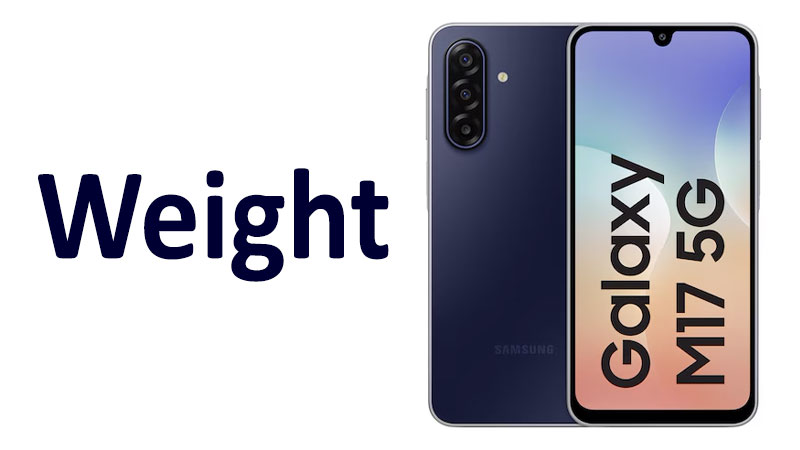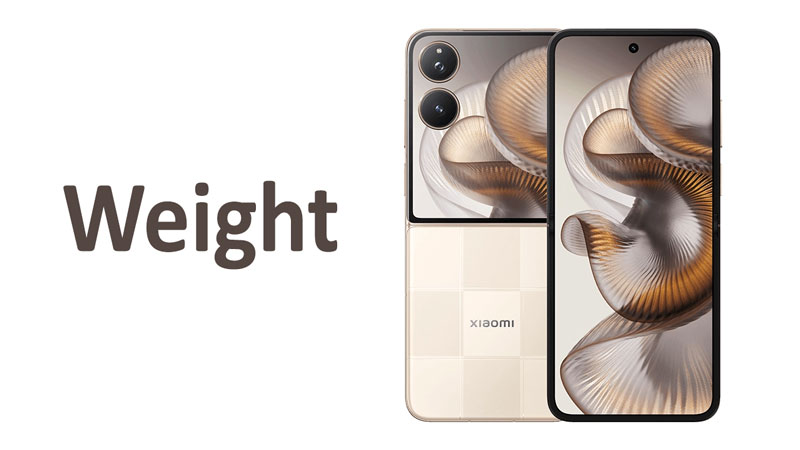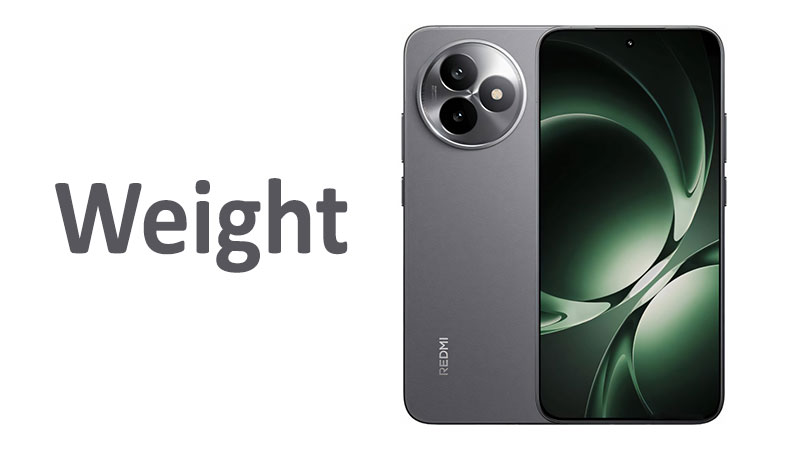The Samsung Galaxy M17 Weight discussion starts immediately with its portability. This key specification affects a user’s daily experience more than many realize. Knowing the device’s mass is vital before making any purchase decision. The M17’s specific weight places it in an interesting category within the budget and mid-range smartphone market. We will explore what 192 grams or 6.77 ounces truly means for the end user. This analysis goes deep into the ergonomics, comparisons with competitors, and the underlying design choices that determine the M17’s heft.
The Core Specification: Understanding the M17’s Mass
Every modern smartphone is a balance of power, battery, and portability. The weight is a direct result of these compromises.
Samsung Galaxy M17 Weight: The Exact Figures
The official weight of the Samsung Galaxy M17 stands at 192 grams. For users who prefer imperial units, this converts precisely to 6.77 ounces. This is not the lightest phone available today. However, it also avoids the classification of a truly heavy or cumbersome device. This figure positions the M17 as a device with a solid, reassuring feel in the hand. It is certainly not feather-light, but it achieves a respectable middle ground.
Contextualizing 192 Grams
To fully appreciate this weight, we can compare it to common objects. A typical deck of playing cards weighs around 100 grams. Therefore, the M17 is slightly less than two full decks of cards. A standard baseball weighs roughly 145 grams. The M17 is noticeably heavier than a baseball. This physical comparison helps establish the phone’s density and feel. When reviewing smartphone specifications, weight often reveals battery capacity and build materials. A sub-200 gram phone usually signifies a focus on daily comfort and ease of handling.
Design and Material Science Behind the M17’s Weight
A phone’s final weight depends heavily on its internal and external components. Samsung’s design choices for the M-series directly influence this 192-gram figure.
The Role of the Battery in Smartphone Weight
The Galaxy M-series is famously known for its large battery capacity. In the past, some M-series phones have exceeded 210 grams. This was directly due to including massive 6,000 mAh or even 7,000 mAh batteries. The 192-gram weight of the M17 suggests a strategic balance. It is highly probable that Samsung has fitted the M17 with a battery in the range of 5,000 mAh. A larger battery demands more weight due to the cell density. A smaller 4,000 mAh unit would certainly make the phone lighter. However, it would compromise the line’s key selling point: battery life. Thus, 192 grams represents an optimized trade-off for all-day power.
Construction Materials: Plastic vs. Glass
The external shell contributes significantly to the overall mass. Premium flagship phones often use glass backs and stainless steel frames. These materials feel luxurious, but they add substantial weight. The Galaxy M17, designed to be budget-friendly, likely utilizes a polycarbonate (plastic) shell. Polycarbonate is a lightweight material. This choice helps to offset the weight of the necessary internal components. If the M17 used an aluminum or glass back, its weight would easily jump past the 210-gram mark. Using plastic ensures durability while keeping the 192-gram target achievable.
Weight Distribution and Perceived Heft
The way the weight is distributed matters as much as the total mass. A well-engineered phone feels lighter than a poorly balanced one, even if their total weight is identical. The M17 likely has its heaviest component, the battery, centered in the device. This centralization prevents the phone from feeling top-heavy or bottom-heavy. A balanced phone is more comfortable to hold for extended periods. This engineering detail is crucial for gaming or long video calls.
Ergonomics and Usability Analysis
The 192-gram mass profoundly impacts the user experience in several key areas. These ergonomic factors determine long-term satisfaction with the device.
Impact on One-Handed Operation
The M17 is comfortable for single-handed use, thanks to its sub-200-gram weight. Phones approaching 220 grams or more often require two hands for secure operation. This weight helps prevent accidental slips and drops during quick tasks. Typing a short message or swiping through social media feeds remains easy. However, users with smaller hands might still find the top of the screen difficult to reach. This is an issue of screen size, not just weight. Still, the manageable weight improves overall stability during these actions.
Hand Fatigue During Extended Use
Long gaming sessions or watching a feature-length movie can cause hand fatigue. Heavier phones put strain on the wrist and fingers. At 192 grams, the M17 offers decent resistance to this fatigue. Professional gamers or heavy media consumers will find this weight acceptable, but not ideal. For comparison, lighter phones around 170 grams are superior for minimal fatigue. The M17 performs well for average use, but it may require occasional hand switching during intensive tasks.
Pocketability and Portability
The combination of the phone’s dimensions and its 192-gram weight affects how easily it fits into clothing. The M17 will slide into most jeans pockets without excessive bulk. The weight is enough to give a reassuring presence without causing major pocket drag. Phones exceeding 200 grams often pull down lighter fabrics. This can be annoying and uncomfortable. The M17 avoids this problem, making it a highly portable choice for daily commuting. The 6.77 ounces of weight ensures easy transport in bags, backpacks, or jacket pockets.
Specialized Comparisons: M17 vs. Its Samsung Siblings
To understand the M17’s weight, we must compare it within the context of the Samsung Galaxy M-series and A-series lineups. This specialized comparison highlights the M17’s design purpose.
Comparing with Previous M-Series Models
The M-series has historically prioritized battery life over sleekness. Older models like the notional M15 or M16 often came in slightly heavier. For example, some predecessors crossed the 200-gram threshold. This was usually attributed to slightly thicker designs or a larger 6,000 mAh battery. The M17’s 192-gram figure shows a clear evolution. Samsung is now engineering more efficient battery cells. This allows them to maintain excellent battery life while reducing the overall mass. The M17 thus offers better hand-feel than some older, bulkier M-series devices. This focus on optimization is a major buyer point.
The M17 vs. Mid-Range M-Series (M3x, M5x)
Higher-end M-series phones, such as the Galaxy M34 or M54, typically carry heavier loads. They often feature larger displays, more advanced cooling systems, and more complex camera modules. These additional components invariably push their weight past the 200-gram mark. For instance, the M54 might weigh around 205-215 grams. The M17 is distinctly lighter than these models. This lighter mass makes the M17 a preferred choice for users who prioritize lightness over maximum power or screen size. This difference of 10 to 20 grams might seem small on paper. However, it is very noticeable in daily handling.
The M17 vs. The Samsung Galaxy A-Series
The Galaxy A-series targets a different audience, often prioritizing aesthetics and slimness. A comparable A-series model might weigh in the 175-185 gram range. These devices often use slightly smaller batteries to achieve a thinner profile. They might also incorporate metal elements, which can sometimes reduce thickness without adding excessive weight. The M17 (192 grams) is slightly heavier than its A-series counterpart. This extra mass in the M17 is a promise. It promises superior battery longevity, which remains the core strength of the M-series lineup.
Comparison with Key Competitors and Rivals
The M17 does not exist in a vacuum. Its 192-gram weight must be measured against similar offerings from rival brands in the budget and mid-range segments.
The Chinese Battery Titans
Many competing brands, particularly those focused on power-user features, also boast large batteries. Xiaomi, Realme, and others often release budget phones that push battery sizes to 6,000 mAh. These devices regularly weigh between 210 and 225 grams. They sacrifice comfort for extreme uptime. Against these “battery titans,” the Samsung Galaxy M17’s 192-gram weight is a significant advantage. It offers a much more comfortable, lighter package. This is a crucial distinction for the M17’s market appeal. It provides excellent battery life without the significant wrist strain of the competition.
The Premium Mid-Range Segment
In the upper-mid-range, competitors start introducing features like glass backs and wireless charging coils. These premium additions typically drive the weight up to 205 to 210 grams. The M17, at 192 grams, avoids this heavier category. This confirms its positioning as a functional, user-friendly device. It focuses on core performance and battery life, not necessarily high-end materials. The lighter feel helps it stand out as a highly portable alternative.
Summary of Weight Advantage
The 192-gram weight is best categorized as an ergonomic sweet spot. It is heavy enough to accommodate a great battery. It is light enough to avoid the fatigue associated with its biggest battery-focused competitors. The Samsung Galaxy M17 achieves a successful middle ground. This makes it an attractive option for the vast majority of everyday users.
Pros and Cons of the Samsung Galaxy M17’s 192g Weight
The specific mass of the M17 offers a distinct set of advantages and disadvantages for the user. Understanding these points is crucial for an informed buying decision.
Advantages (Pros) of 192 Grams
1. Expected Battery Stamina
The 192g weight strongly suggests a large battery, likely 5,000 mAh. This is the primary benefit. Buyers expect multiple days of use from an M-series phone. The heft confirms this expectation.
2. Perceived Durability and Solidity
A heavier phone often feels more robust and less fragile than a very light one. The 192 grams provides a reassuring density. This gives the perception of better build quality and resistance to minor bumps.
3. Balanced Hand-Feel
The weight is properly distributed, creating a secure grip. This reduces the sensation of flimsiness. The phone feels like a substantial and dependable piece of hardware. This improves the overall user confidence when holding it.
4. Reduced Component Cost
The mass is achieved primarily through a large battery and lightweight plastic. This keeps the manufacturing costs lower. These savings are then passed on to the consumer. This makes the M17 an excellent value proposition.
Disadvantages (Cons) of 192 Grams
1. Not the Thinnest or Lightest
Competitors prioritizing thinness will offer devices closer to 175 grams. The M17 is not the ultimate choice for users obsessed with minimal weight or a sleek profile. It is a slightly thicker device overall.
2. Increased Wrist Strain for Specific Users
Heavy readers, cloud gamers, or users who hold their phone overhead in bed may experience slight discomfort. For these niche uses, every gram counts, and 192 grams is on the heavier side.
3. Feeling Less Premium
Flagship phones, even if heavier due to glass and steel, often feel more premium. The M17’s weight, combined with its plastic shell, might not feel as high-end as a pure glass and metal construction. This is a common trade-off in the mid-range.
4. Pocket Drag in Light Clothing
While better than 220g phones, the M17 can still cause slight dragging in very thin shorts or light summer clothing. Users who often wear casual attire should consider this minor inconvenience.
Important Points a Buyer or Reader Should Know
When researching the Samsung Galaxy M17 weight, a buyer should consider how this specification aligns with their personal usage habits.
Weight Plus Case Equals Total Load
The stated 192 grams is for the phone alone. Almost all users immediately add a protective case. A rugged case can easily add 30 to 50 grams. This immediately pushes the total functional weight into the 222 to 242 gram range. Users should anticipate this final weight when assessing daily comfort. A thin silicone case will be less of an issue. A highly protective, thick case will demand a compromise on ergonomics.
Battery Life is the Weight’s Justification
Buyers must understand that the weight is a feature, not a flaw. The 192-gram figure is a commitment to longevity. If a user prioritizes being far away from a wall socket, this weight is justified. If a user values a razor-thin, light design, they should look at smaller-battery alternatives. The Samsung Galaxy M17 weight is directly proportional to its anticipated screen-on time.
Weight and Vibration Feedback
A heavier device often handles haptic feedback better. The linear vibration motor’s rumble feels more subtle and less rattly on a denser phone. The 192-gram mass absorbs small vibrations effectively. This translates to a higher-quality experience when receiving notifications or typing on the virtual keyboard. This is a small but noticeable advantage of a well-weighted phone.
User Group Assessment for M17’s Weight
- Commuters/Business Users: Excellent. The weight is manageable for transport. The implied battery life is essential for long working days.
- Casual Users/Social Media: Very good. It is easy to hold for short scrolling sessions. It provides a secure, comfortable grip.
- Heavy Gamers/Media Consumers: Good, but not perfect. The large screen is great. However, the weight may eventually cause discomfort during marathon sessions. These users might benefit from a third-party controller grip.
Conclusion: The M17 Weight is the Sweet Spot
The Samsung Galaxy M17 weight of 192 grams (6.77 ounces) is a deliberate engineering choice. It represents a successful convergence of durability, battery capacity, and ergonomic comfort. This mass is a testament to Samsung’s understanding of the M-series core audience. That audience demands exceptional battery performance above all else.
The weight is substantial enough to carry a powerful 5,000 mAh-class battery. At the same time, it uses lightweight construction materials to avoid crossing the heavy-device threshold. This makes the M17 highly portable for daily use. It offers a solid, dependable feel without the strain of its 215-gram competitors.
For the budget-conscious buyer, the M17 provides the ultimate combination. It delivers reliable power and acceptable ergonomics. The 192-gram figure is precisely where a high-performing battery phone should land. It is a sweet spot for power and portability in the current smartphone market. You can be confident that the M17 will serve you well for long periods without becoming overly cumbersome.
Frequently Asked Questions (FAQ)
1. Does the Samsung Galaxy M17 weight indicate a large battery?
Yes, the 192-gram weight strongly suggests the inclusion of a high-capacity battery. This is likely in the 5,000 mAh range. This size is typical for the battery-focused Galaxy M-series.
2. How does 192 grams compare to a standard flagship phone?
Many premium flagship phones now weigh over 220 grams. The M17 is considerably lighter than those models. This makes it more comfortable for single-handed use.
3. Is the M17’s weight suitable for long gaming sessions?
The 192-gram weight is generally acceptable for extended gaming. It is not as light as thin-profile phones, but it avoids the hand fatigue caused by devices over 210 grams.
4. Will a protective case make the M17 too heavy?
Adding a heavy-duty protective case will increase the total weight to over 220 grams. For maximum comfort, pair the M17 with a slim, lightweight silicone or polycarbonate case.
5. Why do different reviewers sometimes state slightly different weights for the M17?
Minor variations in weight can occur due to manufacturing tolerances and regional differences. All official measurements, however, cluster very closely around the 192-gram mark.



